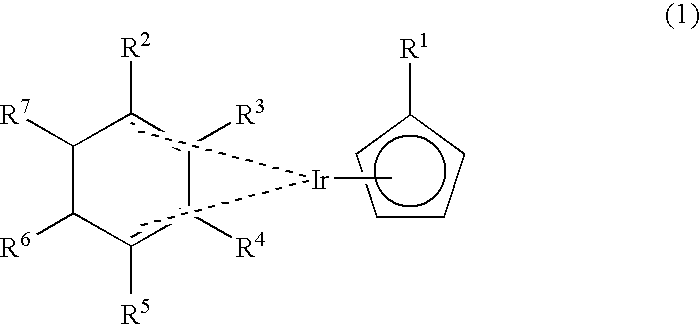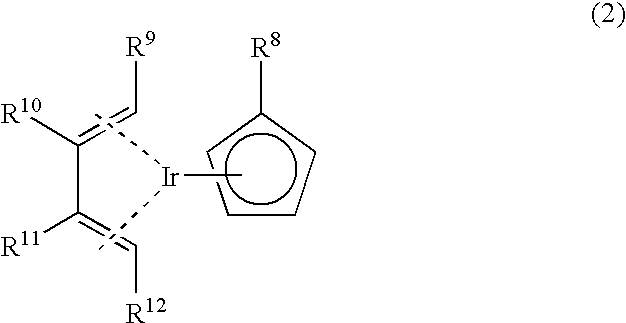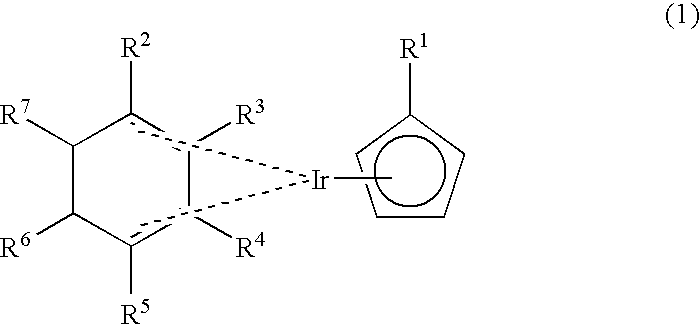Novel organometallic iridium compound, process of producing the same, and process of producing thin film
- Summary
- Abstract
- Description
- Claims
- Application Information
AI Technical Summary
Benefits of technology
Problems solved by technology
Method used
Image
Examples
example 2
Synthesis of (ethylcyclopentadienyl)( 1,3-cyclohexadiene)iridium
[0072] Chlorobis(1,3-cyclohexadiene)iridium was obtained in the same manner as in Example 1. 0.9 g of chlorobis(1,3-cyclohexadiene)iridium was added to 15 ml of THF, and a reaction flask was cooled to -78.degree. C., to which was then added 30 ml of a THF solution of 0.33 g of lithium ethylcyclopentadienide. The mixture was stirred at -78.degree. C. for 30 minutes, the temperature was then raised to room temperature step by step, and the resulting mixture was further allowed to react for 1.5 hours, followed by concentration to obtain a muddy mixture. The muddy mixture was subjected to extraction with hexane, and the extract solution was subjected to distillation under reduced pressure to obtain 827 mg of desired (ethylcyclopentadienyl)(1,3-cyclohexadiene)iridium. It was confirmed that this compound was a desired compound by carrying out the .sup.1H-NMR and MS analyses in the same manner as in Example 1.
example 3
Synthesis of (ethylcyclopentadienyl)(1,3-cyclohexadiene)iridium
[0073] Chlorobis(1,3-cyclohexadiene)iridium was obtained in the same manner as in Example 1. 7.8 g of chlorobis(1,3-cyclohexadiene)iridium was added to 60 ml of THF, and a reaction flask was cooled to -78.degree. C., to which was then added 100 ml of a THF solution of 2.5 g of sodium ethylcyclopentadienide. The mixture was stirred at -78.degree. C. for 30 minutes, the temperature was then raised to room temperature step by step, and the resulting mixture was further allowed to react for one hour, followed by concentration to obtain a muddy mixture. The muddy mixture was subjected to extraction with hexane, and the extract solution was subjected to distillation under reduced pressure to obtain 4.9 g of desired (ethylcyclopentadienyl)(1,3-cyclohexadiene)iridium. It was confirmed that this compound was a desired compound by carrying out the .sup.1H-NMR and MS analyses in the same manner as in Example 1.
example 4
Synthesis of (methylcyclopentadienyl)( 1,3-cyclohexadiene)iridium
[0074] Chlorobis(1,3-cyclohexadiene)iridium was obtained in the same manner as in Example 1. 1.2 g of chlorobis(1,3-cyclohexadiene)iridium was added to 20 ml of THF, and a reaction flask was cooled to -78.degree. C., to which was then added 40 ml of a THF solution of 0.26 g of lithium methylcyclopentadienide. After completion of the addition, the temperature was raised to room temperature step by step, and the resulting mixture was allowed to react for one hour, followed by concentration to obtain a muddy mixture. The muddy mixture was subjected to extraction with hexane, and the extract solution was subjected to sublimation under reduced pressure to obtain 101 mg g of desired (methylcyclopentadienyl)(1,3-cyclohexadiene)iridium represented by the following formula (8). 10
[0075] .sup.1H-NMR (500 MHz, Benzene-d6, .delta. ppm): 4.98 (t, J=2.0 Hz, 2H), 4.93 to 4.97 (m, 2H), 4.87 (t, J=2.0 Hz, 2H), 3.42 to 3.47 (m, 2H), 1.9...
PUM
 Login to View More
Login to View More Abstract
Description
Claims
Application Information
 Login to View More
Login to View More - R&D
- Intellectual Property
- Life Sciences
- Materials
- Tech Scout
- Unparalleled Data Quality
- Higher Quality Content
- 60% Fewer Hallucinations
Browse by: Latest US Patents, China's latest patents, Technical Efficacy Thesaurus, Application Domain, Technology Topic, Popular Technical Reports.
© 2025 PatSnap. All rights reserved.Legal|Privacy policy|Modern Slavery Act Transparency Statement|Sitemap|About US| Contact US: help@patsnap.com



